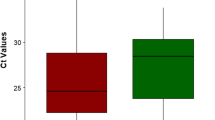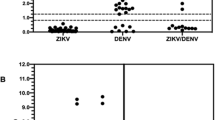Abstract
Purpose
Aedes aegypti mosquito-borne diseases have a significant impact on public health in Brazil. In this study, we investigated the presence of the Zika virus (ZIKV) and dengue virus (DENV) in serum and urine samples from symptomatic participants who attended an Emergency Care Unit located in a city in the northwestern region of São Paulo between February 2018 and April 2019.
Methods
Serum and urine samples were collected from participants suspected of having arbovirus infection. After the extraction of viral RNA, viral detection was performed by real-time quantitative reverse transcription polymerase chain reaction (RT-qPCR) (One-Step RT-qPCR).
Results
A total of 305 participants participated in this study. A total of 283 blood and 270 urine samples were collected. Of 305 patients, 36.4% (111/305) were positive for ZIKV, 43.3% (132/305) for DENV2, and 0.3% (1/305) for DENV1. Coinfection with ZIKV/DENV2 was observed in 13.1% of participants. If only serum samples were used, ZIKV detection would have decreased to 23.3% (71/305). Of all the participants included in the study, only one was suspected of having ZIKV infection based on clinical diagnosis, and the remaining participants were suspected of having DENV.
Conclusion
By testing serum and urine samples, we increased the detection of both viruses and detected considerable levels of ZIKV and DENV-2 coinfection when compared to other studies. Additionally, we detected an unnoticed ZIKV outbreak in the city. These findings highlight the importance of the molecular diagnosis of arboviruses to aid public health surveillance and management strategies.


Similar content being viewed by others
Data availability
The data supporting the findings of this study are available within the article and in its supplementary materials.
References
Weaver SC, Reisen WK (2010) Present and future arboviral threats. Antiviral Res 85(2):328–345. https://doi.org/10.1016/j.antiviral.2009.10.008
Cleton N, Koopmans M, Reimerink J, Godeke GJ, Reusken C (2012) Come fly with me: review of clinically important arboviruses for global travelers. J Clin Virol 55(3):191–203. https://doi.org/10.1016/j.jcv.2012.07.004
Holmes EC (1998) Molecular epidemiology and evolution of emerging infectious diseases. Br Med Bull 54(3):533–543. https://doi.org/10.1093/oxfordjournals.bmb.a011708
Pontes RJS, Ruffino-Netto A (1994) Dengue em localidade urbana da região sudeste do Brasil: aspectos epidemiológicos. Rev de Saúde Pública 28:218–227. https://doi.org/10.1590/S0034-89101994000300010
MS, SVS (2016) Dengue: diagnóstico e manejo clínico: adulto e criança. 5 ed. Brasil: Ministério da Saúde. https://bvsms.saude.gov.br/bvs/publicacoes/dengue_diagnostico_manejo_clinico_adulto.pdf. Accessed 20 Aug 2022
Kuno G, Chang GJ (2007) Full-length sequencing and genomic characterization of Bagaza, Kedougou, and Zika viruses. Arch Virol 152(4):687–696. https://doi.org/10.1007/s00705-006-0903-z
Dick GW, Kitchen SF, Haddow AJ (1952) Zika virus. I. Isolations and serological specificity. Trans R Soc Trop Med Hyg 46(5):509–520. https://doi.org/10.1016/0035-9203(52)90042-4
Duffy MR, Chen TH, Hancock WT, Powers AM, Kool JL, Lanciotti RS et al (2009) Zika virus outbreak on Yap Island, Federated States of Micronesia. N Engl J Med 360(24):2536–2543. https://doi.org/10.1056/NEJMoa0805715
Oehler E, Watrin L, Larre P, Leparc-Goffart I, Lastère S, Valour F et al (2014) Zika virus infection complicated by Guillain-Barré syndrome—case report, French Polynesia, December 2013. Euro Surveill 19(9):20720. https://doi.org/10.2807/1560-7917.es2014.19.9.20720
Musso D, Cao-Lormeau VM, Gubler DJ (2015) Zika virus: following the path of dengue and chikungunya? Lancet 386(9990):243–244. https://doi.org/10.1016/S0140-6736(15)61273-9
Zanluca C, Melo VC, Mosimann AL, Santos GI, Santos CN, Luz K (2015) First report of autochthonous transmission of Zika virus in Brazil. Mem Inst Oswaldo Cruz 110(4):569–572. https://doi.org/10.1590/0074-02760150192
Rasmussen SA, Jamieson DJ, Honein MA, Petersen LR (2016) Zika virus and birth defects—reviewing the evidence for causality. N Engl J Med 374(20):1981–1987. https://doi.org/10.1056/NEJMsr1604338
Calvet G, Aguiar RS, Melo ASO, Sampaio SA, de Filippis I, Fabri A et al (2016) Detection and sequencing of Zika virus from amniotic fluid of fetuses with microcephaly in Brazil: a case study. Lancet Infect Dis 16(6):653–660. https://doi.org/10.1016/S1473-3099(16)00095-5
Moore CA, Staples JE, Dobyns WB, Pessoa A, Ventura CV, Fonseca EBD et al (2017) Characterizing the pattern of anomalies in congenital Zika syndrome for pediatric clinicians. JAMA Pediatr 171(3):288–95. https://doi.org/10.1001/jamapediatrics.2016.3982
WHO (2016) WHO to convene an International Health Regulations Emergency Committee on Zika virus and observed increase in neurological disorders and neonatal malformations. https://www.who.int/en/news-room/detail/28-01-2016-who-to-convene-an-international-health-regulations-emergency-committee-on-zika-virus-and-observed-increase-in-neurological-disorders-and-neonatal-malformations. Accessed 22 Aug 2022
Blitvich BJ, Magalhaes T, Laredo-Tiscareño SV, Foy BD (2020) Sexual transmission of arboviruses: a systematic review. Viruses 12(9):933. https://doi.org/10.3390/v12090933
Chen LH, Wilson ME (2016) Update on non-vector transmission of dengue: relevant studies with Zika and other flaviviruses. Trop Dis Travel Med Vaccines 2:15. https://doi.org/10.1186/s40794-016-0032-y
MS, SVS (2020) Monitoramento dos casos de arboviroses urbanas transmitidas pelo Aedes (dengue, chikungunya e Zika), Semanas Epidemiológicas 1 a 46, 2020. Brasilia, Brasil: Ministério da Saúde. https://www.gov.br/saude/pt-br/centrais-de-conteudo/publicacoes/boletins/boletins-epidemiologicos/edicoes/2020/boletim_epidemiologico_svs_48.pdf. Accessed 1 Aug 2022
Paz-Bailey G, Rosenberg ES, Doyle K, Munoz-Jordan J, Santiago GA, Klein L et al (2017) Persistence of Zika virus in body fluids—final report. N Engl J Med 379(13):1234–1243. https://doi.org/10.1056/NEJMoa1613108
Iannetta M, Lalle E, Musso M, Carletti F, Scorzolini L, D’Abramo A et al (2017) Persistent detection of dengue virus RNA in vaginal secretion of a woman returning from Sri Lanka to Italy, April 2017. Euro Surveill 22(34):30600. https://doi.org/10.2807/1560-7917.Es.2017.22.34.30600
Shinohara K, Kutsuna S, Takasaki T, Moi ML, Ikeda M, Kotaki A et al (2016) Zika fever imported from Thailand to Japan, and diagnosed by PCR in the urine. J Travel Med. https://doi.org/10.1093/jtm/tav011
Korhonen EM, Huhtamo E, Virtala AM, Kantele A, Vapalahti O (2014) Approach to non-invasive sampling in dengue diagnostics: exploring virus and NS1 antigen detection in saliva and urine of travelers with dengue. J Clin Virol 61(3):353–358. https://doi.org/10.1016/j.jcv.2014.08.021
Andries AC, Duong V, Ly S, Cappelle J, Kim KS, Lorn Try P et al (2015) Value of routine dengue diagnostic tests in urine and saliva specimens. PLoS Negl Trop Dis 9(9):e0004100. https://doi.org/10.1371/journal.pntd.0004100
Cabral-Castro MJ, Cavalcanti MG, Peralta RHS, Peralta JM (2016) Molecular and serological techniques to detect co-circulation of DENV, ZIKV and CHIKV in suspected dengue-like syndrome patients. J Clin Virol 82:108–111. https://doi.org/10.1016/j.jcv.2016.07.017
Lanciotti RS, Kosoy OL, Laven JJ, Velez JO, Lambert AJ, Johnson AJ et al (2008) Genetic and serologic properties of Zika virus associated with an epidemic, Yap State, Micronesia, 2007. Emerg Infect Dis 14(8):1232–1239. https://doi.org/10.3201/eid1408.080287
Felix AC, Souza NCS, Figueiredo WM et al (2017) Cross reactivity of commercial anti-dengue immunoassays in patients with acute Zika virus infection. J Med Virol 89(8):1477–1479. https://doi.org/10.1002/jmv.24789
de Vasconcelos ZFM, Azevedo RC, Thompson N, Gomes L, Guida L, Moreira MEL (2018) Challenges for molecular and serological ZIKV infection confirmation. Childs Nerv Syst 34(1):79–84. https://doi.org/10.1007/s00381-017-3641-5
MS. Guia de Vigilância em Saúde. Bull World Heath Organ. 3 ed. Brasília: Ministério da Saúde; 2019. p. 740. https://bvsms.saude.gov.br/bvs/publicacoes/guia_vigilancia_saude_3ed.pdf. Accessed 23 Jul 2022
Johnson BW, Russell BJ, Lanciotti RS (2005) Serotype-specific detection of dengue viruses in a fourplex real-time reverse transcriptase PCR assay. J Clin Microbiol 43(10):4977–4983. https://doi.org/10.1128/jcm.43.10.4977-4983.2005
Lopes N, Nozawa C, Linhares REC (2014) Características gerais e epidemiologia dos arbovírus emergentes no Brasil. Rev Pan-Amaz Saúde. 5:55–64. Disponível em. http://scielo.iec.gov.br/scielo.php?script=sci_arttext&pid=S2176-62232014000300007&lng=pt&nrm=iso. Accessed 23 Jul 2022
Holbrook MR (2017) Historical perspectives on flavivirus research. Viruses. https://doi.org/10.3390/v9050097
Estofolete CF, Terzian ACB, Colombo TE, de Freitas GG, Ferraz HCJ, da Silva RA et al (2019) Co-infection between Zika and different Dengue serotypes during DENV outbreak in Brazil. J Infect Public Health 12(2):178–181. https://doi.org/10.1016/j.jiph.2018.09.007
Colombo TE, Vedovello D, Pacca-Mazaro CC, Mondini A, Araújo JP, Cabrera E et al (2016) Dengue virus surveillance: detection of DENV-4 in the city of São José do Rio Preto, SP. Brazil Acta Tropica 164:84–89. https://doi.org/10.1016/j.actatropica.2016.09.004
Colombo TE, Estofolete CF, Reis AFN, da Silva NS, Aguiar ML, Cabrera EMS et al (2017) Clinical, laboratory and virological data from suspected ZIKV patients in an endemic arbovirus area. J Clin Virol 96:20–25. https://doi.org/10.1016/j.jcv.2017.09.002
Pessôa R, Patriota JV, Lourdes de Souza M, Felix AC, Mamede N, Sanabani SS (2016) Investigation into an outbreak of dengue-like illness in Pernambuco, Brazil, Revealed a Cocirculation of Zika, Chikungunya, and Dengue Virus Type 1. Medicine 95(12):e3201. https://doi.org/10.1097/md.0000000000003201
MS, SVS (2019) Monitoramento dos casos de arboviroses urbanas transmitidas pelo Aedes (dengue, chikungunya e Zika) até a Semana Epidemiológica 12 de 2019 e Levantamento Rápido de Índices para Aedes aegypti (LIRAa). Brasilia, Brasil: Ministério da Saúde
MS, SVS (2018) Monitoramento dos casos de dengue, febre de chikungunya e doença aguda pelo vírus Zika até a Semana Epidemiológica 49 de 2018. Brasilia, Brasil: Ministério da Saúde
MS, SVS (2017) Monitoramento dos casos de dengue, febre de chikungunya e febre pelo vírus Zika até a Semana Epidemiológica 52, 2016. Brasilia, Brasil: Ministério da Saúde
Vogels CBF, Rückert C, Cavany SM, Perkins TA, Ebel GD, Grubaugh ND (2019) Arbovirus coinfection and co-transmission: a neglected public health concern? PLoS Biol 17(1):e3000130. https://doi.org/10.1371/journal.pbio.3000130
Chaves BA, Orfano AS, Nogueira PM, Rodrigues NB, Campolina TB, Nacif-Pimenta R et al (2018) Coinfection with Zika Virus (ZIKV) and dengue virus results in preferential ZIKV transmission by vector bite to vertebrate host. J Infect Dis 218(4):563–571. https://doi.org/10.1093/infdis/jiy196
Carrillo-Hernández MY, Ruiz-Saenz J, Villamizar LJ, Gómez-Rangel SY, Martínez-Gutierrez M (2018) Co-circulation and simultaneous co-infection of dengue, chikungunya, and Zika Viruses in patients with febrile syndrome at the Colombian-Venezuelan border. BMC Infect Dis 18(1):61. https://doi.org/10.1186/s12879-018-2976-1
Cerbino-Neto J, Mesquita EC, Souza TML, Parreira V, Wittlin BB, Durovni B et al (2016) Clinical manifestations of zika virus infection, Rio de Janeiro, Brazil, 2015. Emerg Infect Dis 22(7):1318–1320. https://doi.org/10.3201/eid2207.160375
Karkhah A, Nouri HR, Javanian M, Koppolu V, Masrour-Roudsari J, Kazemi S et al (2018) Zika virus: epidemiology, clinical aspects, diagnosis, and control of infection. Eur J Clin Microbiol Infect Dis 37(11):2035–2043. https://doi.org/10.1007/s10096-018-3354-z
Gourinat A-C, O’Connor O, Calvez E, Goarant C, Dupont-Rouzeyrol M (2015) Detection of Zika virus in urine. Emerg Infect Dis 21(1):84–86. https://doi.org/10.3201/eid2101.140894
MS. Procedimentos a serem adotados para a vigilância da Febre do vírus Zika no Brasil. 2016. https://www.conasems.org.br/wp-content/uploads/2016/03/portalsaude.saude.gov.br_images_pdf_2016_marco_07_Nota-Informativa-zika.pdf. Accessed 15 Jul 2022
MS, SVS. ZIKA ABORDAGEM CLÍNICA NA ATENÇÃO BÁSICA. Brasil, 2016. http://www.saude.pi.gov.br/uploads/warning_document/file/276/livro.pdf. Accessed 13 Jul 2022
de Jesus JG, Dutra KR, Sales FCdS, Claro IM, Terzian AC, Candido DdS et al (2020) Genomic detection of a virus lineage replacement event of dengue virus serotype 2 in Brazil, 2019. Mem Inst Oswaldo Cruz 115:e190423. https://doi.org/10.1590/0074-02760190423
Hirayama T, Mizuno Y, Takeshita N, Kotaki A, Tajima S, Omatsu T et al (2012) Detection of dengue virus genome in urine by real-time reverse transcriptase PCR: a laboratory diagnostic method useful after disappearance of the genome in serum. J Clin Microbiol 50(6):2047–2052. https://doi.org/10.1128/JCM.06557-11
Mizuno Y, Kotaki A, Harada F, Tajima S, Kurane I, Takasaki T (2007) Confirmation of dengue virus infection by detection of dengue virus type 1 genome in urine and saliva but not in plasma. Trans R Soc Trop Med Hyg 101(7):738–739. https://doi.org/10.1016/j.trstmh.2007.02.007
Acknowledgements
We thank the city of Mirassol and the director and staff of the Emergency Care Unit of Mirassol for allowing us to conduct the study. We also thank all participants who contributed to this study. This study was financed by Coordenação de Aperfeiçoamento de Pessoal de Nível Superior—Brasil (CAPES)—Finance Code 001 and Grant number 2046/2016; Conselho Nacional de Desenvolvimento Científico e Tecnológico (CNPq)—Grant number 440723/2016-7 and São Paulo Research Foundation (FAPESP)—Grant Number 2014/22198-0.
Author information
Authors and Affiliations
Corresponding author
Ethics declarations
Conflict of interest
The authors declare that there is no conflict of interest.
Ethical approval
This study was performed in line with the principles of the Declaration of Helsinki. Approval was granted by the Ethics Committee of São Paulo University State—UNESP (CAAE: 66489617.4.0000.5466).
Consent to participate
All participants signed an informed consent form before participating in the study.
Additional information
Edited by Matthias J. Reddehase .
Publisher's Note
Springer Nature remains neutral with regard to jurisdictional claims in published maps and institutional affiliations.
Supplementary Information
Below is the link to the electronic supplementary material.
Rights and permissions
Springer Nature or its licensor (e.g. a society or other partner) holds exclusive rights to this article under a publishing agreement with the author(s) or other rightsholder(s); author self-archiving of the accepted manuscript version of this article is solely governed by the terms of such publishing agreement and applicable law.
About this article
Cite this article
da Conceição, P.J.P., de Carvalho, L.R., de Godoy, B.L.V. et al. Detection of DENV-2 and ZIKV coinfection in southeastern Brazil by serum and urine testing. Med Microbiol Immunol 212, 193–201 (2023). https://doi.org/10.1007/s00430-023-00762-z
Received:
Accepted:
Published:
Issue Date:
DOI: https://doi.org/10.1007/s00430-023-00762-z




